Our Turf
Classic turf is ideal for domestic lawns, commercial landscapes, award-winning show gardens and city squares. For a healthy lawn, that requires less maintenance than some other lawn turf and will happily withstand day to day family use whilst looking lush and green - our Classic Turf is enough to make the neighbours jealous! This widely used grade of turf contains perennial ryegrass and fescues (evergreen tufted grass).
Our turf partner is one of the top turf growing companies in the UK - INTURF, noted for their quality of product.
Below is our handy guide to all things turf including:
- Why you should choose turf
- How to measure up for your turfing requirements
- How to order your turf
- Delivery information
- How to lay your turf
- How to care for your lawn and ensure it looks great now and in the future
There's lots of information here, but our award winning sales team is always on hand to give you advice and help you with your order.
Call our sales team on 01257 263 873 for all your questions and to order your turf.
Why Choose Turf?
There are lots of benefits to choosing turf for your garden over and above the fact that it adds value to your home and provides a beautiful area for leisure and relaxation. Turf is a sustainable way to landscape your garden for the following reasons:
Water Filter
Turf absorbs rainfall and reduces run-off as it allows the water to seep through the soil. It acts like a sponge to store water temporarily in the event of heavy rain and flash floods. In addition it protects surface water quality by filtering and cleaning the water that runs off into streams and drainage systems.
Temperature Control
Within towns and cities, turf, along with other plants and trees, supports significantly lower surface temperatures during the summer, up to 10 degree Celsius cooler than tarmac! This helps reduce the "urban heat island" effect.
Dust Filter
Turf traps smoke, dust and dirt, released annually into the atmosphere, between its leaves. From here the particles are washed into the soil, where they are broken down. In essence turf filters out the air we breathe, which is particularly important in urban areas.
Environmental Benefits
Turf is a unique ecosystem which hosts the interaction between the grass plant and a vast array of organisms and micro-organisms which use it as their home. The turf provides the feeding ground for these micro-organisms, which break down the proteins and carbohydrates in dead leaves and roots into simple compounds that, in return, the grass plants can re-use. Grass also uses greenhouse gasses for photosynthesis thereby offsetting climate change. Mowing clippings and the natural shedding of turf stems and leaves also contributes a large amount of organic matter to the soil over a number of years.
Erosion Prevention
A lawn can support the reduction of soil erosion by intercepting rainfall before it hits the soil. It allows the water to filter through the soil rather than run off it into our water systems.
Noise Reducer
Turfed areas absorb noise more effectively than tarmac or paved gardens. In fact they can decrease noise by eight to ten decibels which is particularly useful in town and cities.
How to Measure Up for Turf
Turf is supplied in conventional rolls of 1 square metre (sqm) with a minimum order of 40 sqm.
To work out how many square metres of turf you need depends on the shape of your lawn.
For a rectangular or square lawn you will need to measure the length and width of the lawn in metres. Then multiply these together to provide the number of square metres of turf you require. (Length x width)
For a triangular lawn the same is done but the final value is then divided by 2 (Length x width divided by 2)
For a circular lawn you will need to measure from the central point of the lawn out to the edge of the lawn in metres i.e. measure the radius of the circle. This length is then multiplied by itself and by 3.14 to give the volume required in metres square. (Radius x radius x 3.14)
For a semi-circular lawn the same is done but the final value is then divided by 2 (Radius x radius x 3.14 then divide by 2)
Given the need to cut around edges and corners it is advised to add on an additional 5% to your total quantity in metres squared. We recommend that you round your order up to the nearest 10sqm metres for ease.
It would be realistic to say that one fit person could lay approximately 100sqm per day.
How to Order Turf
Please order your turf either by calling our Sales Team on 01257 494 121 or by visiting our Classic Turf product page
To place an order you will need:
a) Your turf measurement, rounded up to the nearest 10sqm (See 'how to measure up for tuf ')
b) Your postcode in order to work out delivery charges and dates
PLEASE REMEMBER: We recommend laying your turf within 24 hours of delivery and will help you organise a convenient delivery date to accommodate this when ordering. However, before you start to lay your turf it is important to clear your site of any stones, weeds and debris which may impact on the establishment of the turf. If you have any stubborn weeds you may wish to spray the area with a weed killer, but if you do, please bear in mind that you will need to wait to lay your turf for up to 7 days after application (depending on the chemical used - see pack instructions). This needs to be considered when arranging delivery.
Turf & Bulk Bag Topsoil Delivery
What you need to know about your delivery:
- We'll call you within 24 hours of placing your order to confirm your delivery arrangements
- It's Convenient - no need to wait in all day to sign, we don't need a signature.
- It's Free - Tuesday to Friday between 8am - 6pm
- It's Quick - orders before 11am can be delivered the following day
- It's Tried & Tested - we use only couriers who have shown consistency in their efficiency & care
A bit more detail ...
All our prices include delivery (excluding VAT and any specified surcharges) to most of mainland Britain. For any areas that are not specified within our area bands please call us and we will personalise your delivery. In addition we can deliver to Isle of Man, Isle of Wight, Scottish Islands, Channel Islands, Ireland and the rest of Europe at an agreed supplement. We deliver regularly to all these areas and are experienced in managing delivery costs.
Should you have very specific delivery requirement times we can offer the following windows for a supplement:
- A specific 3-7 hour window
- Morning delivery (8am-1pm)
- Timed delivery between 10am-4pm
- Saturday delivery before 1pm
Our sales team are very experienced in all delivery options - if you would like a specific delivery window cost or have any concerns please ask for advice on 01257 263 873
DO I NEED TO BE AT HOME TO SIGN FOR MY TURF/TOPSOIL?
You do not need to be in for your delivery. It will be a kerbside delivery on a pallet and the driver will leave your turf/topsoil as close to the delivery address as possible. Please leave us instructions in the additional information section, when placing your order, for where your turf should be left, but please be reasonable - we can't expect carriers to leave a pallet "in the shed at the bottom of the garden".
We will also call you within 24 hours of your order to check we have all of the details we may need, so if you miss anything out or want to explain things in more detail don't worry - we'll be in touch.
Don't forget that it is recommended that you lay your turf within 24hours of delivery so we need to plan your delivery date carefully.
We can arrange delivery dates to suit you and we do not charge for this service however, whilst we do our level best to meet requested delivery dates there are always times when there is an unforeseen eventuality like a road accident (rare but it happens!). We probably met 99% of specific delivery dates last year, but just to be clear, we will not pay any compensation if we do not meet a specific delivery date.
If you need to change your delivery date for any reason please do not hesitate to contact us and we will do our best to re-arrange. As turf is such a perishable product you will need to keep a sharp eye on your local weather conditions and contact us before your delivery date if you believe that the conditions are not going to be suitable for you to lay your turf. That way you will have the option to change your delivery date, so you can work in the optimum conditions.
OR PHONE US FOR SPECIFIC DELIVERY DETAILS ON YOUR ORDER
If you have any further concerns and would like to speak to one of our sales team, please ring us on 01257 263 873 and tell us what you'd like to order and when you'd like it to be delivered - and we'll tell you if it's possible and how we'll do it.
How To Lay Your Turf
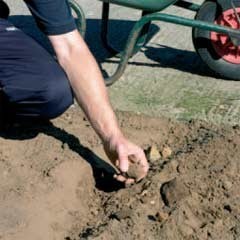
Step 1
As much as possible let the soil dry out then rotavate the site or rake it through, levelling out any high or low spots using topsoil. Roughly set out the shape and contours for the lawn with the soil.
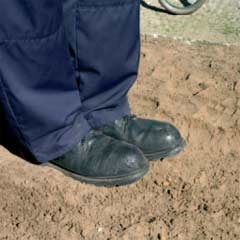
Step 2
The soil needs to be slightly compacted, so using your feet or a garden roller firm down the topsoil. It should be firm enough so that when you walk off the soil it leaves a light impression of your footprint, without sinking. Now's the time to make sure the soil is levelled to the exact shape and contours you want for your lawn.
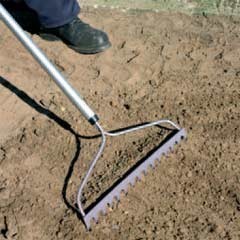
Step 3
Rake a fine surface across the top layer of soil, to a depth of about three quarters of an inch (20mm). If you wish to you could add in some good quality fertiliser at this point such as Terracottem and rake it into the surface, if the soil is of low fertility. It is important to make sure that all of this preparation work is completed prior to arrival of the turf on site
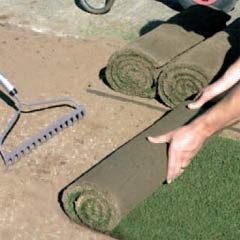
Step 4
Once your turf arrives it's time to start laying. It is important to avoid walking on the newly prepared soil so try to work from planks where possible once your first row has been rolled out along the edge of the area. If you get 2 wooden planks and lay them on the new turf you can stand or kneel on them then the impact you have on the lawn will be less.
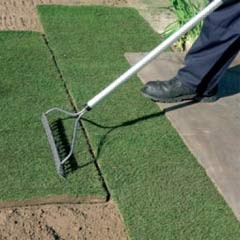
Step 5
It is always best to begin from the longest straight edge of your site. The rolls of turf are laid out end to end, touching each other as much as possible. It is important not to pull the turf in to position but to gently push the ends together so that there are no gaps. Turf is laid out in a brickwork fashion by staggering the joints so that the edges are given less opportunity to dry out.
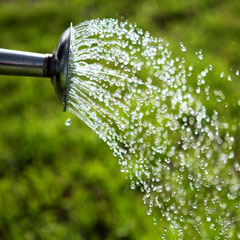
Step 6
Once you've finished laying, water the turf immediately. It is very important to ensure that the water soaks through to the underlying soil; this can be checked by lifting up a corner of the turf to inspect the soil beneath, which should be almost 'drenched'. This watering needs to continue for the first couple of weeks on a daily basis until the lawn is fully established.
Lawn Care Advice
Watering
It is crucial to water newly laid turf as soon as it is down so that it survives. In the UK the rain often helps us out but during drier spells you need to keep your new lawn damp for the first 28 days by watering, after which point the turf should be established enough to fend for itself.
The TGA have the following 10 tips for watering a new lawn:
- Use a soil conditioner to help the soil increase its ability to retain water when preparing the ground for a new lawn.
- Make sure you only order as much turf in each delivery as you can lay in one go so that it doesn't dry out.
- To ensure you are ready to lay the turf a.s.a.p. make sure you have the ground prepared in advance. We recommend you lay your turf within 24hours of delivery (or sooner if possible)
- If you can, stack your turf in a shaded area when it is delivered
- It's a good idea to dampen the soil just before laying
- Press down lightly on the turf as you lay to ensure good contact with the soil
- Water the turf immediately after it has been laid and ensure the soil is damp to a 10cm depth. You can check this by turning up a corner of the turf. You should continue to do this until the turf is established.
- Try to water the turf first thing in the morning or last thing at night so that the sun doesn't dry up any water you have applied.
- Don't over water your turf at any stage as you will create a boggy condition which could lead to moss and grass diseases developing. If it has rained then check the soil first before watering.
- As the turf establishes over the first 28 days water it less and less frequently so it can adapt to fend for itself but don't ever allow it to dry out and go brown in this period.
Mowing
You can start mowing your lawn once it has started to establish. You can tell when this is as the turf will have a 0.5-1 inch white root establishing in the soil. To check if this is the case lift up a corner of the turf and look at the root system. Do not mow the grass when the ground is too wet (i.e. when you can create soggy footprints in the turf with your feet)
In general once the grass is established the 1st mow is done when over three quarters of an inch (20mm) of new growth has appeared. In spring this takes approximately 1 to 2 weeks after laying turf or during the winter months after approximately 4 to 6 weeks. At the start only the new growth of turf should be removed at the first cut. This can slowly be increased if a closer cut is required. As a rule you should never remove more than 25% of growth at any one mowing.
It is best to use a cylinder mower if the lawn is very level and you want a high quality refined grass. Alternatively you can us a rotary mower for a standard lawn with classic grass which needs mowing once a week and has slightly longer fescues.
Important
If the daytime temperature is consistently above 20 degrees and the humidity is high, then the grass plants will struggle to establish and flourish. It will be best to wait until things change to lay the turf, for example if a fall in temperature is predicted or rain is promised.
During these periods we try to avoid dispatching our turf in order to prevent any issues with establishment.
 Hedges Direct
Hedges Direct 



